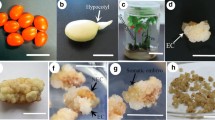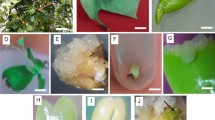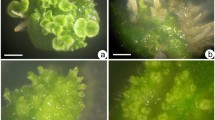Abstract
The effects of plant growth regulators (PGR) on calli induction, morphogenesis and somatic embryogenesis of flax were studied. The organogenic and callus formation capacity were assessed for different types of source explants. Root and shoot explants were equally good material for calli production but the former produced calli without shoot regeneration capacity. Under the experimental conditions tested, 2,4-dichlorophenoxyacetic acid (2,4-D) + zeatin was the most efficient PGR combination on calli induction and biomass production. The calli were green but with no rhizogenic capacity. In contrast, and at similar concentrations, indole-3-butyric acid (IBA) + kinetin induced white or pale green friable calli with a good root regeneration capacity (60%). A factorial experiment with different combinations of 2,4-D + zeatin + gibberellic acid (GA3) levels revealed that the direction of explant differentiation was determined by specific PGR interactions and concentrations. The results from these experiments revealed that the morphogenetic pathway (shoot versus root differentiation) can be manipulated on flax explants by raising the 2,4-D level from 0.05 to 3.2 mg l−1 in the induction medium. The induction and development of somatic embryos from flax explants was possible in a range of 2,4-D + zeatin concentrations surrounding 0.4 mg l−1 2,4-D and 1.6 mg l−1 zeatin, the most efficient growth regulator combination.
Similar content being viewed by others
Abbreviations
- C:
-
shoot segments with the cotyledonary leaves
- 2,4-D:
-
2,4-dichlorophenoxyacetic acid
- GA3 :
-
Gibberellic acid
- H:
-
hypocotyl segments
- IBA:
-
indole-3-butyric acid
- NAA:
-
α-naphthaleneacetic acid
- PGR:
-
plant growth regulators
- R:
-
root segments
References
Baker CM & Wetzstein HY (1994) Influence of auxin type and concentration on peanut somatic embryogenesis. Plant Cell Tiss. Org. Cult. 36: 361–368
Compton ME (1994) Statistical methods suitable for the analysis of plant tissue culture data. Plant Cell Tiss. Org. Cult. 37: 217–242
Cullis CA & Cleary W (1986) DNA variation in flax tissue culture. Can. J. Genet. Cytol. 28: 247–251
Etienne H, Sotta B, Montoro P, Miginiac E & Carron M-P (1993) Relations between exogenous growth regulators and endogenous indole-3-acetic acid and absisic acid in the expression of somatic embryogenesis inHevea brasiliensis (Mull. Arg.). Plant Sci. 88: 91–96
Femandes-Ferreira M, Novais JM & Pais MSS (1989)Calli and suspension cultures for biomass production ofEuphorbia characias L. subsp.characias. Biotechnology Letters 11: 259–264
Femandes-Ferreira M, Novais JM & Pais MSS (1992) Hormonal control of triterpenols synthesis inEuphorbia characias calli. Bioresource Technology 39: 31–37
Fevereiro P, Cabral JMS, Fonseca MMR, Novais JM & Pais MSS (1986) Callus and suspension culture ofSylibum marianum. Biosynthesis of proteins with clotting activity.Biotechnology Letters 8: 19–24
Figueiredo AC, Fevereiro P, Cabral JMS, Novais JM & Pais MSS (1987) Callus and suspension cultures for biomass production ofCynara cardunculus (Compositae). Biotechnology Letters 9: 213–218
Fowler MW & Warren GS (1992) Plant Biotechnology. Pergamon Press, Oxford
Gamborg OL & Shyluk JP (1976) Tissue culture, protoplasts and morphogenesis in flax. Bot. Gaz. 137: 301–306
Green AG & Marshall DR (1984) Isolation of induced mutants in linseed (Linum usitatissimum) having reduced linolenic acid content. Euphytica 33: 321–328
Green AG (1986) A mutant genotype of flax (Linum usitatissimum L.) containing very low levels of linolenic acid in its seed oil. Can. J. Plant Sci. 66: 499–503
King SP & Kasha KJ (1994) Optimizing somatic embryogenesis and particle bombardment of barley (Hordeum vulgare L.) immature embryos. In vitro Cell. Dev. Biol. 30P: 117–123
Lane DW (1979) Influence of growth regulators on root and shoot initiation from flax meristem-tips and hypocotylsin vitro. Physiol. Plant. 45: 260–264
Ling HQ & Binding H (1987) Plant regeneration from protoplasts inLinum. Plant Breeding 98: 312–317
Marshall G & Courduries P (1992) An assessment of somaclonal variation in linseed (Linum usitatissimum). Ann. Appl. Biol. 120: 501–509
Mathews HV & Narayanaswamy S (1976) Phytohormone control of regeneration in cultured tissues of flax. Z. Pflanzenphysiol. 80: 436–442
McHughen A & Swartz M (1984) A tissue-culture derived salt-tolerant line of flax (Linum usitatissimum L.). J. Plant Physiol. 177: 109–117
Murashige T & Skoog F (1962) A revised medium for rapid growth and bioassays with tobacco tissue cultures. Physiol. Plant. 15: 473–497
Murray BE, Handyside RI & Keller WA (1977)In vitro regeneration of shoots on stem explants of haploid and diploid flax (Linum usitatissimum L.). Can. J. Genet. Cytol. 19: 177–186
Nakano M, Hoshino Y & Mii M (1994) Adventitious shoot regeneration from cultured petal explants of carnation. Plant Cell Tiss. Org. Cult. 36: 15–19
Pierik RLM (1987) In Vitro Culture of Higher Plants. Martinus Nijhoff Publishers, Dordrecht.
Punia MS & Bohorova NE (1992) Callus development and plant regeneration from different explants of six wild species of sunflower (Helianthus L.). Plant Sci. 87: 79–83
Santos I, Guimarães I & Salema R (1994) Somatic embryogenesis and plant regeneration ofNerium oleander. Plant Cell Tiss. Org. Cult. 37: 83–86
Schoemaker RC, Amberger LA, Palmer RG, Oglesby L & Ranch JP (1991) Effect of 2,4-dichlorophenoxyacetic acid concentration on somatic embryogenesis and heritable variation in soybean [Glycine max (L) Merr.]. In Vitro Cell. Dev. Biol. 27P: 84–88
Scott TK (1984) Hormonal Regulation of Development II. Springer-Verlag, Berlin. Heidelberg, New York, Tokyo.
Rybczynsky JJ (1975) Callus formation and organogenesis of mature cotyledons ofLinum usitatissimum L. var. Szokijskijin vitro culture. Genetica Polonica 16 No. 2
Yuan YJ, Hu TT & Yang YM (1994) Effect of auxins and cytokinins on formation ofCatharanthus roseus G. Don multiple shoots. Plant Cell Tiss. Org. Cult. 37: 193–196
Author information
Authors and Affiliations
Rights and permissions
About this article
Cite this article
Gomes da Cunha, A.C., Fernandes Ferreira, M. Somatic embryogenesis, organogenesis and callus growth kinetics of flax. Plant Cell Tiss Organ Cult 47, 1–8 (1996). https://doi.org/10.1007/BF02318959
Received:
Accepted:
Issue Date:
DOI: https://doi.org/10.1007/BF02318959




